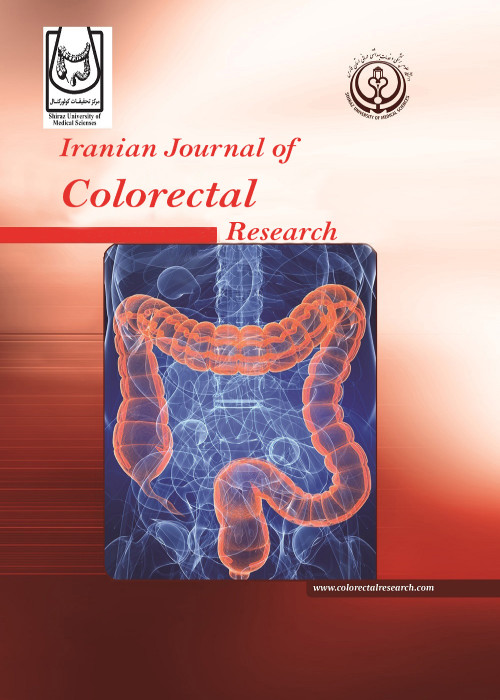فهرست مطالب
Iranian Journal of Colorectal Research
Volume:6 Issue: 2, Sep 2018
- تاریخ انتشار: 1397/06/12
- تعداد عناوین: 4
-
-
Page 1BackgroundObesity is becoming a worldwide health problem. Recently, bariatric surgeries are developing to combat with this problem. However, these surgical methods themselves have risks.ObjectivesThe present study investigated the preventive effect of routine leak test of both gastrojejunal and jejunojejunal anastomoses immediately after laparoscopic Roux-en-Y gastric bypass (LRYGB) surgery against post-operative leak by inexperienced surgeons.MethodsIn a prospective interventional study, this research enrolled 52 morbid obese patients with LRYGB from September 2014 to October 2016. After anastomoses, methylene blue and air leak tests were performed and the section line and both anastomosis sites for patency and inspected for air and dye leaks were examined.ResultsMean body mass index of patients was 48.84 ± 6.8 kg/m2. Twelve patients had positive leak test and the anastomoses were reinforced by additional sutures. All patients were discharged with no leak and no patient had leak during the routine follow-up period.ConclusionsIntraoperative leak test of both gastrojejunal and jejunojejunal anastomoses is a valuable test in the assessment of leak during LRYGB surgery, especially in unskilled surgeons.Keywords: Obesity, Gastric Bypass, Leak Rate, Gastrojejunal Anastomosis, Jejunojejunal Anastomosis, Learning Curve
-
Page 2BackgroundIn recent years, single-port laparoscopic colectomy (SPLC) has been introduced as a new technique for colorectal surgery. Despite several studies, available results are too sparse to accurately identify differences between SPLC and conventional multiport laparoscopic colectomy (MPLC). In a continuing effort, the aim of this study was to compare these two techniques in colon cancer patients.Methods76 patients with colon cancer who underwent either SPLC or MPLC took part in this study. Demographic data and complications such as age, gender, operative time, hospital stay, intra-operative blood volume loss, and internal organ injury were assessed. The patients were followed up for 6 months. Statistical analysis was performed by SPSS software using Student’s t-test, Chi-square test, or Fisher's exact test.ResultsThe complications were similar in both SPLC and MPLC groups. Operative time was significantly lower in SPLC (P = 0.003). No significant differences were observed in other factors (P > 0.05).ConclusionsAccording to studies conducted so far, it seems that the difference in the surgeon's experience, types of the colorectal diseases, and types of the colorectal resection may affect the outcomes like operative time and hospital stay. Therefore, further coherent investigations with larger datasets are essential for a detailed comparison.Keywords: Colon Cancer, Single-Port Laparoscopy, Multiport Laparoscopy, Hemicolectomy
-
Page 3ObjectivesMajor vascular injuries contribute significantly to the mortality of pancreatic and duodenal trauma. We hypothesized that in the setting of penetrating trauma to the pancreas and/or duodenum, independent predictors of mortality associated with vascular injuries could be identified. Our objectives in this study were to describe the national profile of major vascular injuries as well as to identify predictors of morbidity and mortality.MethodsUsing the abbreviated injury scale 2005 and ICD-9-CM E-codes, we identified 597 penetrating pancreatic, duodenal, and pancreaticoduodenal trauma patients with major vascular injuries from the NTDB between 2010 and 2014. We controlled patient-level covariates of age, biological sex, systolic blood pressure (SBP), Glasgow coma score (GCS), pulse, injury severity score (ISS), and organ injury scale (OIS) grade. We estimated multivariable generalized linear mixed models to account for the nesting of patients within trauma centers.ResultsOur results indicated an overall mortality rate of 26.1%. Approximately 19% of patients died within 24 hours of admission, and of those, 78% died in the first 6 hours. The inferior vena cava was the most commonly injured vessel. The average number of associated injuries was 4.9 in pancreatic or duodenal trauma and 5.4 in pancreaticoduodenal. Statistically significant independent predictors of mortality were firearm mechanism, SBP, GCS, and pulse. Specifically, odds of death were decreased with a 10-mmHg higher admission SBP (7.7% decreased odds), one-point higher GCS (12.8%), and a 10-beat lower pulse (11.6%).ConclusionsThis study is the first to examine the effect of major vascular injuries in the setting of penetrating trauma to the pancreas and/or duodenum utilizing the NTDB. We have identified patterns of injury and statistically significant independent predictors of morbidity and mortality.Keywords: Abdominal Vascular Trauma, Penetrating Trauma, Tiger Country, National Trauma Data Bank
-
Page 4IntroductionFibroadenomas are one of the most common benign breast lesions, however they have also been found on rare occasions elsewhere. These lesions usually arise from mammary-like glands (MLG) of the anogenital region which were first described by van der Putte.MethodsThis case is about a 51-year-old female who presents with symptomatic hemorrhoids and a 5 cm nodular lesion external to the anal verge. These were removed and examined histo-pathologically.ResultsPathology revealed three hemorrhoidal specimens and the nodular lesion which was consistent with a fibroadenoma. Histologically, the nodular lesion demonstrated a benign process with ductal proliferation and estrogen receptors.ConclusionsFibroadenomas in anatomic locations other than the breast are very uncommon. Other sites noted in prior case reports include gallbladder, prostate, arm, eyelid and anogenital region. Most of the anogenital lesions have been found on the vulva, with only six documented cases in the anal region, making this pathology exceedingly rare.Keywords: Fibroadenoma, Mammary-Like Glands, Anogenital Lesion, Perianal Lesion


